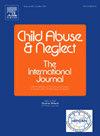法医男性患者群体中各种不良童年经历的患病率:一项系统回顾和荟萃分析
IF 3.4
2区 心理学
Q1 FAMILY STUDIES
引用次数: 0
摘要
长期以来,早期创伤暴露一直被认为是不良心理健康结果和犯罪行为的风险因素。然而,对获得法医心理健康服务的男性早期生活的了解仍然有限。目的:本综述旨在综合证据,并报告男性法医(非监狱)人群中不良童年经历(ACE)的综合患病率估计。方法对七个数据库进行系统的文献检索,以确定同行评议的文章,这些文章报道了在接受法医精神卫生服务的男性中直接“童年虐待”和间接“家庭”ace的患病率。生成随机效应模型以确定总患病率。结果共纳入19篇论文,25篇以西方样本为主(n = 16353名参与者)。大多数(69%)的文章被评价为低质量,尽管没有发现基于质量的患病率估计有显著差异。尽管关注度较低,但对父母分居(51.9%,95% CI: 42 - 61%)、情感忽视(42.7%,95% CI: 29 - 57%)和家庭药物滥用(38.6%,95% CI: 31 - 47%)的综合患病率估计最高。所有ace均存在高度异质性。结论考虑到最常见的ace类型与寻求治疗的男性法医人群中最普遍的ace类型之间的不一致性,需要在研究和临床实践中关注一系列早期逆境。讨论了未来研究的几点启示和途径。本文章由计算机程序翻译,如有差异,请以英文原文为准。
Prevalence of types of adverse childhood experiences in forensic male patient populations: A systematic review and meta-analysis
Background
Exposure to early trauma has long been recognised as a risk factor for poor mental health outcomes and offending behaviour. Nevertheless, insight into the early lives of males accessing forensic mental health services remains limited.
Objective
This review sought to synthesise evidence on, and report the combined prevalence estimates of, adverse childhood experiences (ACE) in male forensic (non-prison) populations.
Methods
A systematic literature search of seven databases was conducted to identify peer-reviewed articles reporting the prevalence of direct ‘childhood maltreatment’ ACEs and indirect ‘household’ ACEs in males accessing forensic mental health services. Random effects models were generated to determine pooled prevalence rates.
Results
Overall, 19 papers were included, representing 25 predominantly western samples (n = 16,353 participants). The majority (69 %) of articles were appraised as low quality, though no significant differences in prevalence estimates based on quality were found. Despite being of lesser focus, highest pooled prevalence estimates were obtained for parental separation (51.9 %, 95 % CI: 42–61 %), emotional neglect (42.7 %, 95 % CI: 29–57 %) and household substance abuse (38.6 %, 95 % CI: 31–47 %). High heterogeneity was apparent for all ACEs.
Conclusion
In consideration of the incongruity between the types of ACEs most commonly investigated and those most pervasive in treatment-seeking male forensic populations, the need to attend to a range of early adversities in both research and clinical practice is indicated. Several implications and avenues for future research are discussed.
求助全文
通过发布文献求助,成功后即可免费获取论文全文。
去求助
来源期刊

Child Abuse & Neglect
Multiple-
CiteScore
7.40
自引率
10.40%
发文量
397
期刊介绍:
Official Publication of the International Society for Prevention of Child Abuse and Neglect. Child Abuse & Neglect The International Journal, provides an international, multidisciplinary forum on all aspects of child abuse and neglect, with special emphasis on prevention and treatment; the scope extends further to all those aspects of life which either favor or hinder child development. While contributions will primarily be from the fields of psychology, psychiatry, social work, medicine, nursing, law enforcement, legislature, education, and anthropology, the Journal encourages the concerned lay individual and child-oriented advocate organizations to contribute.
 求助内容:
求助内容: 应助结果提醒方式:
应助结果提醒方式:


